This is the multi-page printable view of this section. Click here to print.
Characters
1 - Simplified skills
These rules are canon for my current campaign.
These rules are designed to hopefully prune back the skill list a little in ways that make sense and make some skill-heavy archetypes have a little bit of an easier time of it (most notably, riggers and deckers.)
Skill group cost changes
Reduce karma cost to level up a skill group from 5x new rating to 4x new rating. Skill Groups are less powerful than attributes, so shouldn’t cost the same to advance. In addition, few Skill Groups contain three or more equally useful skills, so charging them as double the normal skill cost seems more balanced.
This is designed to make it less painful to use Skill Groups as a way of mitigating the large numbers of skills needed for some archetypes.
Remove skill group points entirely at chargen. Instead, increase skill points available as follows:
- Skills Rank A now gets 66 (instead of 46/10)
- Skills Rank B now gets 46 (instead of 36/5)
- Skills Rank C now gets 32 (instead of 28/2)
- Skills rank D still gets 22
- Skills rank E still gets 18
At chargen, allow Skill Groups to be taken for 2x Skill Points per point going into the Skill Group. This is so players are free to mix and match skills and skill groups as they desire.
Example
Sally Samurai puts a B into skills during chargen. She wants to be good with all sorts of instruments of murder, so she takes the Firearms skill group to rating 5 - this costs her 10 of her 46 skill points.
Later, during play, she decides to improve her skills. First she takes her Firearms skill group from from 5 to 6, which costs 24 karma. Then she decides to focus on rifles, so she takes her Longarms skill (which is part of the Firearms skill group) from 6 to 7. This costs a further 14 karma.
The skill group is now “broken.” She won’t be able to improve it further unless she first takes each of the other skills in the group up to 7.
Skill and skill group changes
In the below tables, changes to SR5 RAW will be highlighted in yellow.
Magic skills
- Add a new “Astral” skill group, spanning the Arcana, Assensing, and Astral skills.
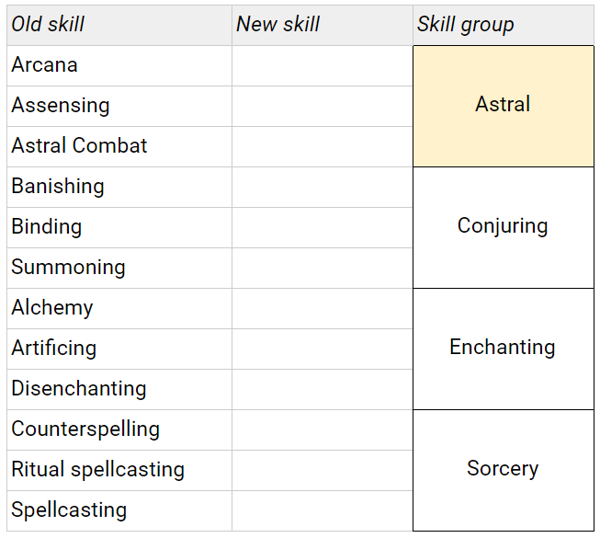
Combat skills
- Rename the Pistols skill to “Handguns”
- Remove the Automatics skill
- Move machine pistols and SMGs into the Handguns skill
- Move carbines and assault rifles into the Longarms skill
- Add Gunnery to the Firearms group
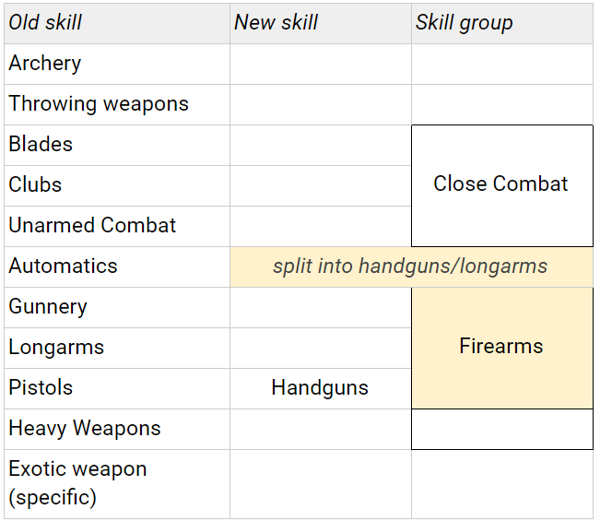
Social skills
- Merge Instruction into the Leadership skill
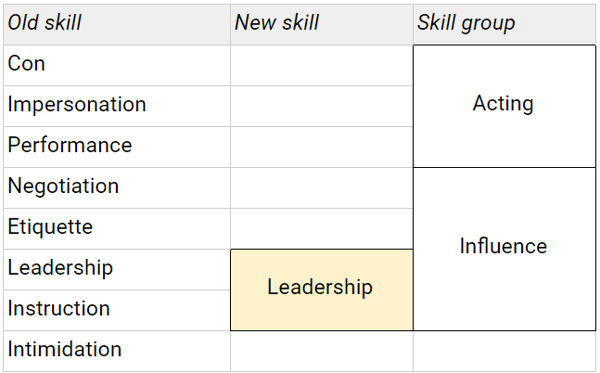
Physical active skills
- Merge Navigation into the Tracking skill
- Merge Free-fall into Gymnastics
- Add Locksmith to the Stealth group
- Merge Diving into Swimming (because honestly, Diving, wtf?!)
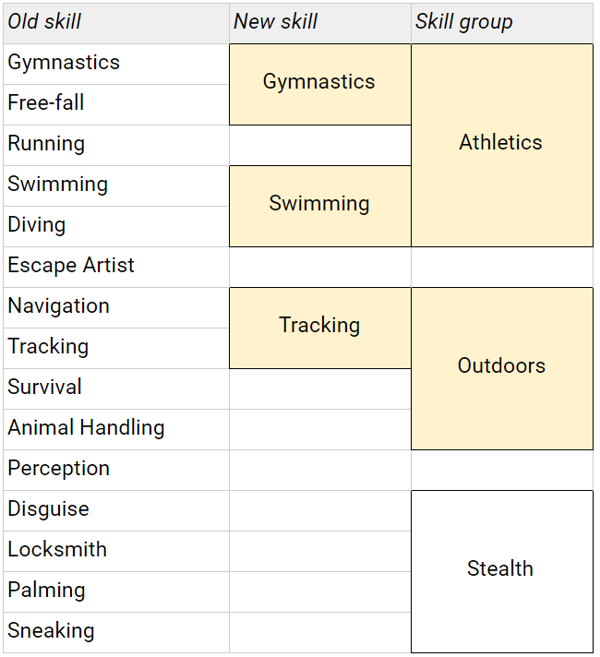
Decking / Technomancer skills
- No changes here.
- But the cheaper skill groups should allow deckers to cover all their bases for a bit less karma/skill points than they could before.
- Deckers are perhaps the only archetype who, per RAW, have skill groups with three all-killer-no-filler skills in.
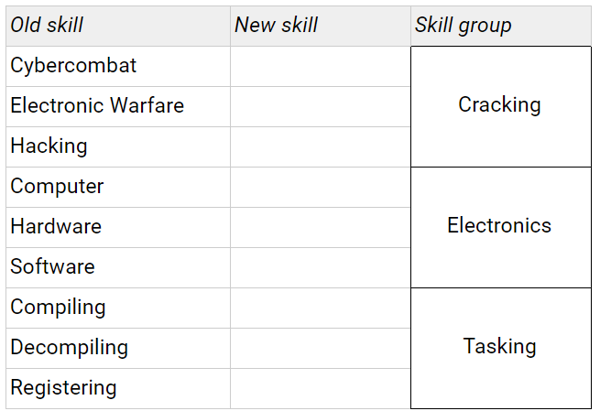
Piloting skills
- Merge Pilot Aerospace into Pilot Aircraft.
- Merge Pilot Walker into Pilot Groundcraft
- Add a Rig Vehicle skill group.
- This can only be taken by characters with Vehicle Control Rig cyberware. Piloting an aircraft and a motorbike with your hands is very different… but doing it via a rig is a more similar experience.
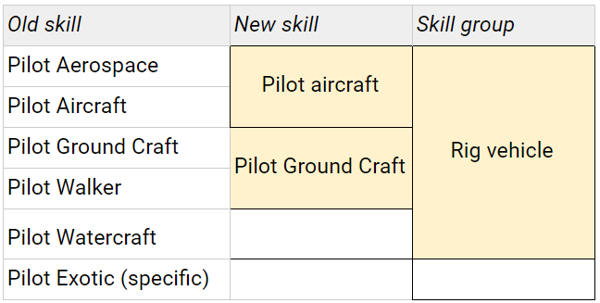
Technical skills
- Merge the various Mechanic skills into a single skill.
- Again, designed to reduce rigger skill crunch and increase flexibility
- Merge Biotechnology and Cybertechnology into Medicine
- Put Chemistry into the Biotech skill group
- Delete Forgery skill
- Electronic forgery eg. cloning a keycard moves into Computers
- Physical artefact forgery eg. faking an ID pass with a photo moves into Artisan
- Add Fabrication skill group
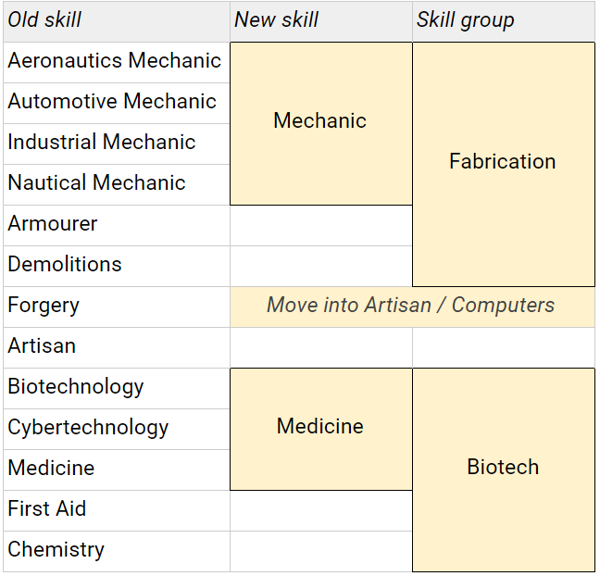
Knowledge and Language Skills
No changes to 5e’s RAW, so to summarise:
- Characters receive free Knowledge and Language skills points equal to (Intuition rating + Logic rating) x 2.
- These points are spent in the same way as other skill points, meaning that spending 1 point gives 1 rank in a skill.
- In addition to the free points, your character receives one language that they know as a native language at no cost.
- To increase knowledge or language skills during play, it costs 1x the new rating (so taking a skill from 1 to 3 costs 2+3=5.)
- See also my downtime houserules, which give you free karma to spend on knowledge and language skills.
Design notes
Goals
- Remove some redundant skills.
- Make some archetypes easier to handle skill wise, particularly deckers and riggers. Allow decker or rigger to be a more viable secondary archetype, and make decker/rigger hybrids more feasible.
- To give mages less painful ways to pick up lesser, but still useful, skills like counterspelling via cheaper skill groups.
Non-goals: Radical upheaval that requires significant changes elsewhere in the system. I’ve mostly stuck to merging existing skills, rather than redrawing the boundaries of skill areas entirely.
Acknowledgements
2 - Downtime
These rules are canon for my current campaign.
After each mission, your characters will (usually) enjoy a downtime phase. During this phase, you get four “scenes” that you can allocate to activities as you please. You also have to pay one amount of your lifestyle costs.
You get two bonus scenes - so, six in total - if you have any of the following augmentations: sleep regulator bioware (CRB); metabolic control adept power (CRB); booster endosont symbiotes (CF pg 123) or hyper-glucagon geneware (CF pg 160).
Spending one scene can give you any of the below options and benefits. Note: almost all tests for activities should be resolved by buying hits, except for a few noted exceptions, and Edge cannot be used in downtime to effect test outcomes. Ask me if you’re not clear if you should roll or buy hits.
Also note: you have to spend at least one scene on Leisure. All work and no play makes Jack an unhappy shadowrunner. If something happens that prevents you from spending a scene on Leisure, you cannot heal stun damage or refresh your Edge pool. Yes, ouch.
Karma & nuyen activities
Leisure
A scene spent on leisure gives you:
- 3 free karma to spend on knowledge skills
- an additional 1 free karma to spend on qualities - either buying new positive ones (at 2x the listed price, as is normal for buying new qualities in play) or buying off existing negative ones.
- A complete refresh of your Edge pool.
- Heal all stun damage.
You can save these karma points up, and you can combine them with regular karma to buy knowledge skills or qualities.
Reflection & self-improvement
You gain 1 karma, to spend on whatever you want.
Working for the man / people
Convert nuyen to karma or karma to nuyen, at a rate of 2000¥:1. You can convert up to five points for one scene. You can only do this once per downtime phase.
Training Montage
Except where noted below, increasing skills or attributes doesn’t require any scenes. You pick it up on the job, so to speak. Knowledge skill increases never require a scene.
However, these increases do need some investment during downtime:
- Increasing an attribute to higher than 2 points less than your racial maximum (ie 4 for humans): 2 scenes
- Increase a skill beyond 6: 2 scenes
Side Hustle
You spend time pitching your skills to do side jobs for your contacts and your contacts’ contacts. See calculation below. Most characters can earn 750-2000¥ for one scene spent on Side Hustle. You can only spend one scene on this; your contacts and their contacts only have so many opportunities for these sorts of off-the-books odd jobs.
See side hustle calculation for details on how to calculate the money earned.
Social activities
Hang Out
Earn a number of Favour Markers equal to your Charisma. You can use these to pay off markers you owe or bank them against future times you ask the contact for help. You don’t need to declare which contacts the markers apply to now, you can hold them as a pool and use them for whichever contact you want later.
You should expect to have to owe contacts Favour Markers when you ask them for help during play. See TBD link
Increase contact loyalty
You can raise a contact’s loyalty by spending a number of markers equal to twice their new loyalty value. I will encourage you to do a bit of roleplaying around this event! However, note you cannot raise a contact’s loyalty if you owe them any Favour Markers.
New Friends
Try and make a new contact, of any type you want.
Choose a contact rating for your new contact. Do an opposed test between your Charisma and the contact rating. If it succeeds, you find someone who will trust you enough to become a contact.
Yes, this means you’re unlikely to make friends above connection 3-5 this way. More powerful friends will need GM approval or to be made during normal play.
At the end of the downtime, the new contact will have loyalty 1.
Recovery activities
Rest & Recuperation
One scene is enough rest to heal any amount of physical damage short of being in overflow. If the character went into overflow on the last run, it takes two scenes to heal up. If you have a medical support contract, this is free. Otherwise it costs one favour marker per scene used.
Lie Low
If you didn’t gain any notoriety during your last mission, you can spend 1 scene to reduce your notoriety by 1. You can only do this once per downtime phase.
Equipment related activities
Acquire Gear
First, find the base number of markers this is going to cost you, depending on the item’s price:
| Cost of item | Number of favour markers |
|---|---|
| Below 5000¥ | 0 |
| 5000 - 50k¥ | 1 |
| 50k - 100k¥ | 2 |
| 100k - 250k ¥ | 3 |
| 250k+ | 4 |
You have to pay these markers for anything you buy, even legal items. They represent the extra hassle of buying expensive items when you don’t legally exist.
Now, work out if you can get it. Each pass through this table takes one of your downtime scenes, except for the first row.
| Avail score (legal gear) | Avail score (R or F) | Outcome |
|---|---|---|
| Below 18 | Below 9 | You get it automatically. This doesn’t need you to use any scenes, either. You still pay markers as above. |
| 18+ | 8-12 | If you have any gear-related contact, you get it automatically; if not, you or any contact can roll. If you use a non-gear contact, this costs +1 marker. |
| 13-18 | If you have a gear contact specialising in this type of gear, you get it automatically. If not, you or any gear contact can roll (again, this costs +1 marker.) | |
| 18+ | A gear specialist contact can roll. This costs +3 favour markers. |
(These numbers err somewhat on the side of generosity.)
If the result is “can roll”, remember you are rolling against the availability of the item, as a dice pool. You can purchase extra dice on this test at a cost of 25% of the item per dice. Remember, for very big-ticket items (high-end cyberware, big vehicles, cyberdecks, etc) it can be more effective to negotiate to receive them as ‘run payouts rather than sourcing them through contacts.
Repair Gear
If you have an appropriate skill (Hardware for Matrix damage, Mechanic for vehicle/drone damage, etc), you can repair up to your total dice pool in damage track boxes across any of your gear for one scene’s worth of your time. You can spend multiple scenes on this if your gear is really badly banged up.
You have to have access to a facility; either a Garage/Workshop/Facility in your dwelling or access to one via a contact.
TODO
Write clearer rules for the requirements here. The ones in Run Faster are silly.There is no further cost; a supply of parts comes with the nuyen you paid for the garage/workshop/facility.
Get Augmented
It takes time to have ‘ware installed, recover from the surgery, and then learn how to use your new abilities. This varies with how invasive the ‘ware is:
- 0-1 Essence: 1 scene
- 1-2 Essence: 2 scenes
- 2-3: 4 scenes
- 3+: 6 scenes
Magic related activities
Magical Initiation
Take an extended test: Arcana + Intuition [Astral] (initiate grade, 4 scenes)
If you can’t get all of this done in one piece of downtime, you can “bank” the scenes you have spent and to return to it during the next downtime phase.
Learning spells
First buy the formula (see below.) Then resolve a test of (Spellcasting + Intuition) [magical lodge’s force]
Like most downtime actions, don’t roll actual dice, just buy hits.
Substitute in Ritual Spellcasting or Alchemy if that’s what you’re learning
Learning the spell takes two entire scenes, divided by the number of hits on the test. This means you can learn more than one spell in a single scene, as long as you have 4+ hits on the test. Other than that, you don’t get any sort of refund for part-used scenes, however.
Create alchemical trinkets
You can create a number of trinkets equal to your Alchemy skill in a single downtime scene. See Reagents in the Magic section for more information.
- Choose how many drams of reagent to use
- Roll Alchemy + Magic (this will usually be rolled and not fall back to buying hits)
- Resultant trinket has Force equal to the lesser of the roll and the number of drams used.
NB: Regardless of resulting power, all the reagents you declared in step 1 are consumed.
Addiction related activities
See addiction houserules for full details on these.
- Indulge - lose 0/1/2/4 scenes if you choose to indulge your addiction, depending on its level (mild/moderate/severe/burnout)
- Go cold turkey - lose no scenes, but you have to roll for withdrawal at the start of the next mission
- Rehab - spend 1-3 scenes undergoing therapy and treatment for your addiction. Each scene offers a cumulative +2 bonus to your next withdrawl roll. There’s also an escalating cost: 1 scene costs 1000¥, the second costs 2500¥, and the third costs 10k¥.
You can’t combine indulge and rehab.
Other activities
Each scene can be used for 60 hours of downtime to do things like binding spirits, enchanting, making gear, etc. Anything that needs extended tests in the book and isn’t mentioned above can be done via this scene.
Modified downtime rules to account for qualities
Shadowrun has many, many qualities, and probably lots of them should affect the rules above. These are just the ones I’ve thought of so far.
- Side Hustle and Day Job: if you have Day Job, you must spend downtime scenes working.
- at the 5 karma level, you have to spend one scene working.
- at the 10 karma level, you have to spend two scenes working, but earn a minimum 1,500 nuyen.
- at the 15 karma level, you have to spend three scenes working; you earn a minimum 2,500 nuyen.
Other qualities I think should affect these downtime rules, but I haven’t yet had a player take them so don’t have numbers at the moment:
- Dependent: reduce scenes
- Addiction: reduce scenes when it gets past a certain level
Side hustle calculation
First, choose a skill you are going to use to freelance. Find your highest relevant skill dicepool on this list:
| Skill | Base |
|---|---|
| Medicine, Biotechnology, Cybertechnology | 4 |
| Technical skills (except the ones above) | 3 |
| Pilot Aircraft, Pilot Aerospace, Pilot Exotic <br/> Sneak | 2 |
| Social Active skills<br/>Combat Active skills<br/>Professional knowledge skills<br/> Arcana <br/>Pilot Walker, Pilot Watercraft | 1 |
| Academic knowledge skills <br/> Pilot Groundcraft | 0 |
Add +1 to this for every rank you have in the skill over 4. Don’t include things like improved ability, reflex recorder, etc - just the normal skill score.
Add bonuses (these all stack):
| Skill | Bonus |
|---|---|
| One or more specialisations in your chosen skill | 1 |
| At least 4 ranks in any Influence skill (Leadership, Negotiation, Etiquette) that you are not using for the skill you are selling | 1 |
| At least 4 ranks in a skill related to the skill you have chosen | 1 |
| At least 4 ranks in 4+ skills related to the skill you have chosen | 1 (plus the 1 above) |
| Have a rating 6 fake SIN, or a real national/corporate SIN | 1 |
| You have a control rig & are using a vehicle skill | 2 |
| You have the Fame quality at National or higher level | 1 |
| Your best fake SIN is of rating 3 or below | -1 |
| No fake SIN, or your best fake SIN is rating 1 | -1 (plus the -1 above) |
| Lifestyle is Squatter | -1 |
| Lifestyle is Street | -2 |
Add all these together to get your multiplier.
Finally, work out how many hits you can buy in your chosen skill - that’s your dice pool, divided by 4, rounded down.
Each scene spent freelancing will earn you:
multiplier * bought hits * 50¥
Example
Twitch the decker decides to do some computer freelancing on the side. He has the Software skill at 6, which is a Technical skill, so has a base multiplier of 3, plus 2 for his skill level. He also has four other computer related skills at rank 4 or above (giving +2). His final multiplier is 7.
His Software skill dice pool is 15, so he can buy 3 hits.
Each scene of freelancing will earn Twitch 7350 = 1050¥.
Blitz the rigger has a go too. She has Pilot Aircraft skill at 7, Agility 6, and a level 2 vehicle control rig. She has various other vehicle related skills, a specialisation in Pilot Aircraft, and Negotiation rank 5. Her multiplier is 11, her bought hits are 4, and so her earnings are 2200¥.
This is a fair bit of crunch but each character should only need to do it once.
Remember, characters can only spend one scene on doing this sort of work before there are no more opportunities to be done. They don’t have the right sort of criminal networks and reputation to find these jobs endlessly. If they did, they probably wouldn’t be shadowrunners.
Side hustle example activities:
- Deckers - small-scale theft/fencing of low-value paydata; spider work securing illegal business’ Matrix stuff; repairing other people’s gear
- Riggers - package delivery (for packages of varying illegality); smuggling; repairing other people’s drones
- Street sams / physads - paid muscle; bodyguards
- Mages - Astral security for illegal business, providing low-level spirits for one-off services
- Face - running cons, negotiators on others behalf
- Medicine skills - patching people up, light including cyberware repair
- Everyone - training others in their skills
Appendix: important acknowledgements
I didn’t realise I wanted downtime rules until I looked at the ones from A Light In the Dark… then I immediately saw that I did. A few things didn’t fit though; they’re optimised for a living campaign, so they’re a bit too detailed in places and a bit too simple in others.
So I wrote my own, which you can read here.
I’ve never been completely happy with how I’ve handled downtime. It felt a little like an underbaked idea, a randomised tax the GM imposes; “well done for finishing that run. It’s now going to be… ummm, let’s say three weeks until your next one. Pay lifestyle costs. OK next run!” This system puts players in control, with a series of options they can pursue. Hopefully, the balancing works where all the options have their own attractions, without anything being overly powerful or creating a cognitive dissonance around “well, why are these people shadowrunners, then?”
I’ve tried to minimise dice rolling, including a speedy gear acquisition path that makes stuff easier to get hold off when the schedule isn’t tight. I’ve added a sort of resource currency for contacts, to represent the flow of favours back and forth to them, and hopefully give a little flavour of being part of a group of criminals. I’ve added zero-cost healing and repair options to recover between runs.
I’ve also taken the chance to buff a few things I feel are a little underpowered in RAW. Sleep regulators become quite potent, for example. Faces should shine here, able to butter up contacts for future favours as well as find new contacts more easily. People with good technical skills might make a non-trivial amount of nuyen on side hustles, which is more for feel and plot hooks than anything else.
Feedback welcomed! I’m still very much moving some of the numbers around, and trying to balance options against each other; I expect this will continue as it gets a proper playtest. But to tell me if you spot any egregious oversights or exploits.
For all the work I’ve done, this remains very closely based on these houserules for A Light In The Dark SR living campaign. All credit for any goodness here belongs to them. Anything you don’t like was probably something I added. More credit goes to u/mercilessming_, from whose houserules I derived further inspiration & the term “scene” which was much better than what I had before..
3 - Contacts rules
These rules are canon for my current campaign.
These rules introduce a simple currency for contacts: favour markers. Certain services from your contacts will cost markers; either instead of, or in addition to, nuyen.
Contacts will generally refuse to help you when you owe them more markers than they have Loyalty rating with you.
Markers are an in-universe concept; characters can talk about them. They can even be traded around (“You still owe me for that time in Cuba. But if you help my boy here out, we’ll be square. OK?”)
Contact types
For each contact you should declare a speciality, an area of expertise. Some examples are below but feel free to ask for more if you feel these don’t cover something you want:
- Legwork: Knows things, or finds them out. Examples: Bartender, Journalist, Info Broker
- Gear: Has things, sells things, finds things. Examples: Talismonger, Armorer, Car Dealer
- Service: Does things. Examples: Mechanic, Smuggler, Medic, Janitor
- Networking: Knows people; can introduce you. Examples: Fixer, Club Owner
Marker costs
Contacts don’t generally have stats. Unless otherwise specified, when it says “roll” below, the roll is:
- ((Connection Rating × 3)+Loyalty rating) if this is the contact’s area of expertise
- ((Connection Rating × 2)+Loyalty rating) otherwise
| Action | What the Contact Does | Cost |
|---|---|---|
| Legwork (Knowledge Skills) | Rolls vs threshold based on obscurity of knowledge | For Legwork contacts: free.Otherwise, 1 marker. |
| Legwork (Asking Around) | Rolls vs threshold based on obscurity of knowledge | For Legwork contacts: 1 marker.Otherwise, 3 markers. |
| Networking | Rolls vs threshold of the target NPC’s connection rating. Even on a success, you might only meet with a subordinate. | For Networking contacts, none. Otherwise, 1 marker. Arranging a meeting with dangerous people (like mafia dons or dragons) might cost more, at the GM’s discretion. |
| Gear | Rolls vs. Availability of item (opposed test, not threshold.) | For Gear contacts, see above. Otherwise, as above, plus 1 additional marker. |
| Services | Rolls their appropriate active skill or uses their special ability. | For service contacts, 1 marker for up to 8 hours of work. Otherwise, 3 markers per 8 hours. |
Using other people’s contacts
If you want to make use of someone else’s contacts, they need to pay the favour markers, not you.
4 - Addiction rules
These rules are not yet canon for my current campaign. Although simpler than RAW, they are still too complex, I feel.
Addiction qualities
(Unchanged from RAW; repeated here for ease of reference.)
- Mild (4 karma): If suffering from withdrawal, the character takes a -2 penalty to all tests that use Physical and/or Mental attributes, depending if the addiction is physiological, psychological, or both.
- Moderate (9 karma): Withdrawal penalty is now -4.
- Severe (20 karma): constant -2 to all Social tests as the character’s degradation becomes obvious to everyone. Same -4 when in withdrawal as for Moderate addiction.
- Burnout (25 karma): -3 to all Social tests. -6 penalty to all Mental and/or Physical attribute tests when in withdrawal.
- Beyond burnout: each time a character in Burnout fails an addiction test, they permanently lose 1 point from either Body or Willpower, whichever is higher.
Dry Addict (also in mild/moderate/severe/burnout levels, at 50% of the karma of the above qualities): must pass a composure test at thresholds 1-5 (depending on stress level) to turn down an offer of the addictive substance. Take a 1-4 dice pool penalty on addiction tests following use of substance.
Addictive substances
| Addiction Threshold | Recovery Period | Addiction Period | Addiction Type | |
|---|---|---|---|---|
| Alcohol [*] | 2 | 1 | 3 | Both |
| Bliss | 3 | 1 | 3 | Both |
| Cram | 3 | 1 | 3 | Psychological |
| Jazz | 3 | 2 | 2 | Both |
| Kamikaze | 3 | 3 | 1 | Physiological |
| Long Haul | 1 | 1 | 3 | Psychological |
| Nitro | 3 | 3 | 1 | Both |
| Novacoke | 2 | 2 | 2 | Both |
| Zen | 1 | 1 | 3 | Psychological |
| BTL (Dreamchip) | 1 | 2 | 2 | Psychological |
| BTL (Moodchip) | 2 | 2 | 2 | Psychological |
| BTL (Personafix) | 2 | 2 | 2 | Psychological |
| BTL (Tripchip) | 3 | 2 | 2 | Psychological |
| Essence Drain | 2 | (Critter’s Magic)/3 | [*] | Psychological |
Notes
For the purposes of my campaign, I won’t be enforcing addiction rolls against soykaf, skillwires, simsense, or foci. I’ve removed them from the table above. I will only ask for rolls for addiction to alcohol when the character already has the qualities ie. an existing addiction can get worse but a character cannot acquire an addiction during play.
I’ve also deleted psyche completely. Deepweed has no addictiveness ratings in CRB, nor in any errata I can find. I’ve left it out for now.
Addiction Period is a new field, calculated as RAW’s “addiction rating” divided by 3. Recovery Period is calculated as (4-Addiction Period.) You can use these formulae to work out the stats for other drugs in SR5e not included above. That’s also how you calculate the values for Essence Drain addiction, should it come up.
Addiction tests
When asked to roll an Addiction or Withdrawal test, the dice roll is:
- Physiological: Body + Willpower vs Addiction Threshold for the drug
- Psychological: Logic + Willpower vs Addiction Threshold
- Both: roll both tests, if either fails then the whole test fails
Addiction during missions
If you have an addiction and start a mission after not indulging in your addiction during the last downtime, you must roll for withdrawal. Roll an addiction test as above. If you fail, you take an ongoing penalty on all rolls, according to your addiction level, as listed above. This will vanish immediately if you use the drug again.
If you use any addictive drugs during the mission that you do not already have an addiction to, make a note that during the next downtime you will experience cravings.
Addiction during downtime
Cravings
Drugs are more-ish. That’s kinda their whole deal.
After any use of an addictive substance, your character will crave it. This will last for a number of downtime sessions equal to the drug’s Addiction Period. Keep track of how many missions you use the drug on while this is happening.
At the end of the Recovery Period, make an Addiction Test. Subtract one from the drug’s Addiction Threshold for each entire mission where you didn’t use the drug at all. You cannot use Edge on this test. If you pass the test, the cravings end and you’re in the clear. If you fail the test, bad news: you now have the Addict (Mild) quality.
Characters with the Dry Addict quality take a penalty of -1 to -4 on this test, depending on the level of their former addiction. In addition, if they fail the test, they get the Addict quality at the same level as their Dry Addict quality, not at the Mild level.
If you pick up an addiction quality this way, you do not receive any karma for it.
Addiction-related downtime scenes
Addictions place certain requirements on you between your missions, as per my downtime houserules.
You can choose to Indulge your addiction. This means you will suffer no ill-effects during your next mission. However, you lose a number of downtime scenes according to your addiction level:
- Mild - 0 scenes lost
- Moderate - 1 scene
- Severe - 2 scenes
- Burnout - 4 scenes (this means you will not be able to do a Leisure scene, so will not heal stun damage or recover Edge during downtime. Yes, this hurts.)
Instead of indulging, you can go cold turkey: you will have to roll for withdrawal at the start of your next mission, and take the penalty for withdrawal if you fail (or choose to get a fix during your next mission.)
Finally, you can choose to rehab, for 1-3 scenes of time. Each scene will grant you +2 dice on your next Addiction Test. There is an escalating cost associated with this, as your character spends time in therapy, purchases detox meds, undergoes magical treatments, etc. In a given downtime phase, the first rehab scene costs 1000¥, the second costs 2500¥, and the third costs 10k¥.
The downward spiral
After a number of consecutive downtime phases and missions during which you indulge your addiction equal to the drug’s Addiction Period, you must roll an Addiction Test. You cannot use Edge on this test. If you fail, the addiction gets one step worse (Mild -> Moderate, Moderate -> Severe, etc.) You do not gain karma for the worsening addiction. If you are at Burnout and fail this test, you stay at Burnout, but also permanently lose one point of either Body or Willpower - whichever is higher.
Getting clean
To get clean, a character must:
- Successfully go cold turkey for Recovery Threshold downtime phases in a row
- not have used the drug during missions
- make one final successful Addiction Test (you can use Edge on this test, but this Edge will not return until after your next Downtime phase.)
- and pay the karma to buy off the negative quality (at 1x price, so 4 karma for a Mild addiction.)
They can then swap the Addiction quality for Dry Addiction. They do not receive karma for this new negative quality.
After another period of (Recovery Threshold) downtimes of complete abstinence (ie. you cannot have rolled any Addiction Tests at all), they can once again pay karma (at 2x the cost of the Dry Addict quality) to remove that as well.
5 - Posthumans
These rules are not currently canon for my current campaign.
Just as metahumankind’s understanding of magic has altered in the decades since it returned to the world - with the emergence of UMT providing a framework for understanding all magical traditions - so too does its understanding of the effect of cybernetic augmentations on the manaflow through an individual. The old theories - that cyberware was fundamentally antithetical to the flow of life force and that as cyberware increased so the subject’s essential humanity inevitably ebbed away - no longer hold true. Instead, a new, deeper understanding is emerging from theoretical thaumaturgists in leading research labs.
It is true that cyberware seems to disrupt the flow of mana being channelled for magic, and it continues to be the case that even small amounts of augmentation is devastating for an individual’s ability to wield magic. But studies of people receiving posthetic limbs or transgender surgeries revealed surprising results - if anything, their interaction with the mana flow improved as the physical reality of their bodies moved into closer alignment with their mental self-image. It now seems that the harmful side-effects of disrupted mana flow are not inevitable, and come not from some immutable law of nature but rather from conflict between the individual’s body and that internal sense of self.
Furthermore, that sense of self is not fixed, but can change over and time through the individual’s will.
For many of metahumankind, it remains harmful to take too much cyberware. On some deep level, their psyche rejects it. But there is an emerging trend of people who choose to see the world, and their place in it, differently. For these people, their relationship with the mana flow is altered in such a way as they can choose greater amounts of augmentation. Their self-image is that as they alter themselves, they are not straying away from what they were meant to be; rather, they move closer to it.
They do not become less than human. They become… something else, something different. Posthuman.
Rules for posthumans
Posthuman is a quality that can only be taken post-chargen and only by characters whose current Essence is 2 or less. It costs 20 points of karma, plus 10 points per level (so 30 points for level 1, 40 for level 2, 50 for level 3…) Each level gives the user a 1-point essence “hole” they can choose to install cyberware, bioware, or other body modifications into without changing their current essence score.
Posthumanism does not mix well with awakened abilities. The total penalty to a character’s magic score is always equal to the sum total of the essence cost of all ‘ware installed, regardless of the Posthuman quality.
Posthumans pride themselves on the perfection of their altered bodies and should always seek to install the highest quality ‘ware they can. They also shun and pity cyberzombies, their twisted cousins, as unnatural creations.